
 What cultural responsibilities does an African themed park hold towards both its subject matter and its audience? Should it choose to represent the continent as an alien land of exotic unfamiliarity to appeal to the visitors’ simultaneous curiosity and repulsion when faced with The Other? Does the theme want us to admire the superior authenticity of African culture over western culture for its supposed deep rootedness in nature? Or should it assume a sermonizing theme of global community and shared responsibility of nature and humanity on all continents? If the park keeps living creatures in captivity, how does it present their story to a paying audience? Are animals merely a subject of scientific curiosity to spin a lesson in ecology around, or might the park want to indulge in a bit of showmanship and include an additional philosophical narrative about the “Circle of Life” within nature, presumably to assuage our self-consciously human anxieties over death?
What cultural responsibilities does an African themed park hold towards both its subject matter and its audience? Should it choose to represent the continent as an alien land of exotic unfamiliarity to appeal to the visitors’ simultaneous curiosity and repulsion when faced with The Other? Does the theme want us to admire the superior authenticity of African culture over western culture for its supposed deep rootedness in nature? Or should it assume a sermonizing theme of global community and shared responsibility of nature and humanity on all continents? If the park keeps living creatures in captivity, how does it present their story to a paying audience? Are animals merely a subject of scientific curiosity to spin a lesson in ecology around, or might the park want to indulge in a bit of showmanship and include an additional philosophical narrative about the “Circle of Life” within nature, presumably to assuage our self-consciously human anxieties over death?
These sorts of questions are rarely points of discussion among theme park fans who often take as a given the theme’s form and content and are more interested in dissecting the technical details that sustain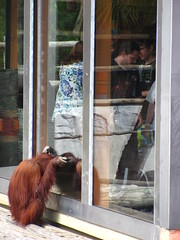 the illusion. Early filmmakers very quickly realized the power their medium had to create emotionally compelling messages simply through the juxtaposition of moving images representing the world around them; sometimes enough to start a revolution, but more often used just to quietly record and comment on some part of human existence that we might have overlooked before. Theme parks by comparison, despite having a much greater level of immersion by constructing the theatrical stage in a space that the audience physically inhabits, never really realized the same potential that film has to create something of social worth that goes beyond the immediate entertainment value. Not that there weren’t some theme park designers who tried, but even in those cases the public generally overlooked or rejected their attempts, and they ultimately didn’t influence the cultural discourse in the same way that other arts have. Whether this tendency in theme parks to overemphasize the mode over the message is a fluke, a conspiracy, or something inherent in the theme park medium, I could write an entire thesis examining and still not get to the bottom of it.
the illusion. Early filmmakers very quickly realized the power their medium had to create emotionally compelling messages simply through the juxtaposition of moving images representing the world around them; sometimes enough to start a revolution, but more often used just to quietly record and comment on some part of human existence that we might have overlooked before. Theme parks by comparison, despite having a much greater level of immersion by constructing the theatrical stage in a space that the audience physically inhabits, never really realized the same potential that film has to create something of social worth that goes beyond the immediate entertainment value. Not that there weren’t some theme park designers who tried, but even in those cases the public generally overlooked or rejected their attempts, and they ultimately didn’t influence the cultural discourse in the same way that other arts have. Whether this tendency in theme parks to overemphasize the mode over the message is a fluke, a conspiracy, or something inherent in the theme park medium, I could write an entire thesis examining and still not get to the bottom of it.
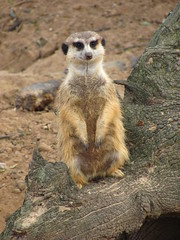 I won’t offer any of my own perspectives on the questions raised in the introduction beyond what you may already assumed by the way the questions were framed. The point is that there are always choices a designer makes over how to present a theme in a park (I want to use the word “theme” here in the literary sense, i.e. “what is it about?”; rather than as a synonym for hyperrealistic decorations, i.e. “what does it look like?”), and these choices can have more significance than simply how they maximize entertainment value. A true theme park is another form of storytelling that interprets an artistic representation of the world to an annual audience of millions, and like any other popular author the theme park bears a certain responsibility for the message it disseminate into the cultural discourse. Even if the themed environment claims total commitment to unbiased authenticity, it still must make selective choices over what to include or exclude, and the context in which we encounter it. There’s no such thing as a neutral theme.
I won’t offer any of my own perspectives on the questions raised in the introduction beyond what you may already assumed by the way the questions were framed. The point is that there are always choices a designer makes over how to present a theme in a park (I want to use the word “theme” here in the literary sense, i.e. “what is it about?”; rather than as a synonym for hyperrealistic decorations, i.e. “what does it look like?”), and these choices can have more significance than simply how they maximize entertainment value. A true theme park is another form of storytelling that interprets an artistic representation of the world to an annual audience of millions, and like any other popular author the theme park bears a certain responsibility for the message it disseminate into the cultural discourse. Even if the themed environment claims total commitment to unbiased authenticity, it still must make selective choices over what to include or exclude, and the context in which we encounter it. There’s no such thing as a neutral theme.
Yet compared to the other animal theme parks in central Florida that are very upfront about having a particular point of view on their subject matter (SeaWorld Orlando and Disney’s Animal Kingdom), Busch Gardens Tampa maintains a relatively neutral relationship to its primary theme. A visitor is unlikely to learn anything particularly deep or compelling about the African condition beyond a few unflashy appeals to conserve the environment and to help feed the children, as could be expected in this age of corporate social responsibility. I’ve never been to Africa, and apart from getting a closer look at some of its native wildlife the continent remains just as much an enigma to me now as it did before I visited the park. Maybe I needed to watch more of their live entertainment?
their subject matter (SeaWorld Orlando and Disney’s Animal Kingdom), Busch Gardens Tampa maintains a relatively neutral relationship to its primary theme. A visitor is unlikely to learn anything particularly deep or compelling about the African condition beyond a few unflashy appeals to conserve the environment and to help feed the children, as could be expected in this age of corporate social responsibility. I’ve never been to Africa, and apart from getting a closer look at some of its native wildlife the continent remains just as much an enigma to me now as it did before I visited the park. Maybe I needed to watch more of their live entertainment?
Nevertheless, there is something to admire in their self-contained neutrality that is missing from its more flamboyant counterparts in Orlando. Unlike sister park SeaWorld, which goes off the deep end in its attempts to ethically justify its animal shows with an all-encompassing, half-assed narration promoting some vaguely defined mystical naturalism, for the most part Busch Gardens allows its animals to simply be animals, without attempting to spin their existence into a story form that makes them more relatable to humans; at least not much more than any other contemporary western zoo. And unlike their primary competitor Disney’s Animal Kingdom, which is all about total immersion into an imaginative story-world designed to feel as if you’ve actually traveled to another continent to view these exotic species, Busch Gardens emphasizes the immediate reality of these creatures watching you on the opposite side of the glass, all amid their luscious botanical gardens that are cultivated here, on this continent in suburban Tampa.
at least not much more than any other contemporary western zoo. And unlike their primary competitor Disney’s Animal Kingdom, which is all about total immersion into an imaginative story-world designed to feel as if you’ve actually traveled to another continent to view these exotic species, Busch Gardens emphasizes the immediate reality of these creatures watching you on the opposite side of the glass, all amid their luscious botanical gardens that are cultivated here, on this continent in suburban Tampa.
The park is at its most effective when it doesn’t attempt to literally re-create Africa (which, as noted in the first few paragraphs, contains all sorts of moral hazards in terms of selective interpretations of a continent that’s so politically troubled and misunderstood by western audiences), but instead use the influences of African art, architecture, and landscaping to create a wholly unique environment that has no original referent anywhere else in the world. For examples, see the rich floral color palate of the original Bird Gardens, or the whimsical African-inspired artistry that adorns the station and queuing area of the new Cheetah Hunt roller coaster. An added benefit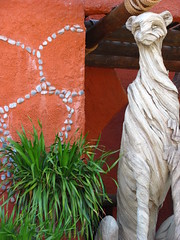 of this approach is that the naked roller coaster structures don’t detract from the beauty of the park’s vistas as they might in a hyperrealist environment like Disney’s Animal Kingdom where the illusion of alternate reality can never be broken. The colorful blue, green, or red waving patterns made by the steel track serve to complement the intrinsic aesthetic appeal of the botanical displays and abstract art designs that line the midways. The end result is a park landscape that I simply found to be pleasant space to spend the day walking around, where I neither felt overwhelmed by the details and visual activity of a more traditional theme park, nor alienated by the unexpressive clutter that defines many contemporary heavy metal amusement parks. Somehow Busch Gardens strikes a balance that, for me, is close to ideal.
of this approach is that the naked roller coaster structures don’t detract from the beauty of the park’s vistas as they might in a hyperrealist environment like Disney’s Animal Kingdom where the illusion of alternate reality can never be broken. The colorful blue, green, or red waving patterns made by the steel track serve to complement the intrinsic aesthetic appeal of the botanical displays and abstract art designs that line the midways. The end result is a park landscape that I simply found to be pleasant space to spend the day walking around, where I neither felt overwhelmed by the details and visual activity of a more traditional theme park, nor alienated by the unexpressive clutter that defines many contemporary heavy metal amusement parks. Somehow Busch Gardens strikes a balance that, for me, is close to ideal.
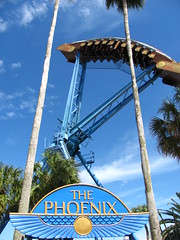 Of course it doesn’t all live up to this ideal. Some areas, such as Timbuktu or the northern half of Stanleyville, feel a bit like outdated remnants from when Busch first discovered the easy marketability
Of course it doesn’t all live up to this ideal. Some areas, such as Timbuktu or the northern half of Stanleyville, feel a bit like outdated remnants from when Busch first discovered the easy marketability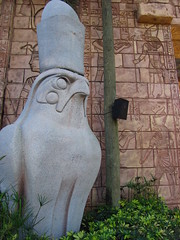 of mechanical rides in the 1970’s. Some of the cultural entertainment, particularly in the Morocco section, veers too much toward ethnic stereotypes (as hilariously noted by Aasif Mandvi for The Daily Show). The Egyptian expansion, lacking any of the eponymous gardens, overcompensates with some grand but lifeless “Egyptian Themeing” that tries too hard to imitate the style of Disney or Universal and comes up short, especially unaided by the nearby presence of some loud and tacky carnival games
of mechanical rides in the 1970’s. Some of the cultural entertainment, particularly in the Morocco section, veers too much toward ethnic stereotypes (as hilariously noted by Aasif Mandvi for The Daily Show). The Egyptian expansion, lacking any of the eponymous gardens, overcompensates with some grand but lifeless “Egyptian Themeing” that tries too hard to imitate the style of Disney or Universal and comes up short, especially unaided by the nearby presence of some loud and tacky carnival games to fill in the empty space in the mock bazaar. (Really, a Hi-Striker at Busch Gardens?) Then there’s Rhino Rally, which could have been Busch Garden’s signature animal-based attraction and instead somehow has become
to fill in the empty space in the mock bazaar. (Really, a Hi-Striker at Busch Gardens?) Then there’s Rhino Rally, which could have been Busch Garden’s signature animal-based attraction and instead somehow has become such a resounding misfire that’s probably best for visitors to avoid completely. Fortunately, these specific points of critique all become minor issues when spread across 335 acres.
such a resounding misfire that’s probably best for visitors to avoid completely. Fortunately, these specific points of critique all become minor issues when spread across 335 acres.
Maybe it’s just because it’s not in the superficial consumerist Mecca that is Orlando (although I’m sure Tampa is hardly any better), but Busch Gardens is perhaps the only theme park in Florida that could make me want to voluntarily return to Florida again just to visit a theme park I’ve already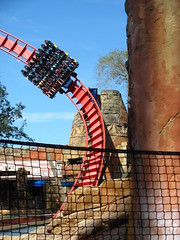 been to. I’m sure much of that is due to the fact that Busch Gardens has far and away the highest caliber roller coaster collection anywhere in the Sunshine State, which I concede perhaps gives away
been to. I’m sure much of that is due to the fact that Busch Gardens has far and away the highest caliber roller coaster collection anywhere in the Sunshine State, which I concede perhaps gives away my bias in attraction preferences. But I’ll defend my preference by noting that attractions like Disney or Universal are, by their design, like movies. I can be hugely entertained by them once or twice, but I don’t have any desire to experience the same story repeatedly unless I also happened to become the type that annually pilgrimages to Comic-Con. Roller coasters, by contrast, are more like a pop song. Find a couple you really like, and there’s little shame in putting them on repeat until you have every beat memorized
my bias in attraction preferences. But I’ll defend my preference by noting that attractions like Disney or Universal are, by their design, like movies. I can be hugely entertained by them once or twice, but I don’t have any desire to experience the same story repeatedly unless I also happened to become the type that annually pilgrimages to Comic-Con. Roller coasters, by contrast, are more like a pop song. Find a couple you really like, and there’s little shame in putting them on repeat until you have every beat memorized and it’s time to go to sleep.
and it’s time to go to sleep.
Before delving into some of those coasters in more detail below, it should perhaps be interesting to note that Busch’s big five includes a terrain-based Intamin Blitz coaster and twin GCI wooden coasters, which normally I’d expect to be the real rocks stars in the park given the quality of similar installations by these manufacturers. Yet these both prove to be relatively weak links, and it’s the trio of B&M designs (Kumba, Montu, and SheiKra) that really shine, despite the firm’s frequent reputation elsewhere for supplying reliable but vanilla-flavored thrill ride hardware.
big five includes a terrain-based Intamin Blitz coaster and twin GCI wooden coasters, which normally I’d expect to be the real rocks stars in the park given the quality of similar installations by these manufacturers. Yet these both prove to be relatively weak links, and it’s the trio of B&M designs (Kumba, Montu, and SheiKra) that really shine, despite the firm’s frequent reputation elsewhere for supplying reliable but vanilla-flavored thrill ride hardware.
Gwazi
Many expected that replacing the original two-bench PTC trains with a sleek new set of Millennium Flyers in 2011 would finally solve the “problem” facing this middling GCI dueling coaster, long known for a rough ride that never quite lived up to expectations. Unfortunately, riding it today with the new trains indicates that the problem must run much deeper than just the choice of rolling stock. Is the problem just that it’s still unpleasantly rough? (When I visited, the Millennium Flyers treated the rails like a giant prank hand buzzer; a sensation as uncomfortable as most older wooden coasters that loosely shuffle around the curves, but with none of the character.) Even if it were to be completely re-tracked down to the support ledgers, I suspect that a smooth Gwazi would amount to little more than a lukewarm series of broad swooping turns and drawn-out transitions, randomly repeated until it’s time to call the kitties home. Gwazi was designed at a time when GCI’s layouts were in transition, and features neither the tight rhythmic pacing of their recent installations,
quite lived up to expectations. Unfortunately, riding it today with the new trains indicates that the problem must run much deeper than just the choice of rolling stock. Is the problem just that it’s still unpleasantly rough? (When I visited, the Millennium Flyers treated the rails like a giant prank hand buzzer; a sensation as uncomfortable as most older wooden coasters that loosely shuffle around the curves, but with none of the character.) Even if it were to be completely re-tracked down to the support ledgers, I suspect that a smooth Gwazi would amount to little more than a lukewarm series of broad swooping turns and drawn-out transitions, randomly repeated until it’s time to call the kitties home. Gwazi was designed at a time when GCI’s layouts were in transition, and features neither the tight rhythmic pacing of their recent installations,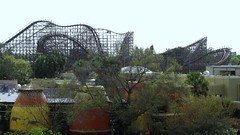 nor the uncontrolled bluntness of their earliest work. Instead it takes an RCCA approach to wasting wood on oversized elements built high above the ground, only with just steep enough banking to make sure no sustained lateral forces are felt on the entire layout. The only unique quality is the dueling “fly-by” moments, but even these were improved upon a year later on the elegant Lightning Racer. Here, they look impressive in third-person promotional video footage, but for riders on board the technique is as visually effective as observing dolphins from a water slide.
nor the uncontrolled bluntness of their earliest work. Instead it takes an RCCA approach to wasting wood on oversized elements built high above the ground, only with just steep enough banking to make sure no sustained lateral forces are felt on the entire layout. The only unique quality is the dueling “fly-by” moments, but even these were improved upon a year later on the elegant Lightning Racer. Here, they look impressive in third-person promotional video footage, but for riders on board the technique is as visually effective as observing dolphins from a water slide.
Montu
Very, very good… but not great. It seems the design team’s strategy for Montu back in 1996 was to copy everything they did three years earlier on Kumba, and then make certain features the opposite so that it wouldn’t be Kumba. Inverting the seat orientation, or carving the track down into the ground rather than raising the ground to contour around the track, are two of the more important changes to the design; but I want to focus on the layout sequence. It shares an identical seven-looping arrangement with certain elements turned around or inside out, such as the Immelmann (loop, then twist) standing in for the dive loop on Kumba (twist, then loop), clockwise rather than counterclockwise rotation on the zero-G barrel roll, the batwing functioning as an inverse cobra roll, or swapping a second corkscrew for a second vertical loop. The problem is that none of these layout choices seem to have been made for any reason other than to not repeat themselves on Kumba, and as a result Montu doesn’t flow between elements as naturally as its older brother. The midcourse block brake section is the biggest drawback because it takes the same up-down rhythm established by the inversions preceding it but fills it with dead space instead, not helped by the excessive reduction of speed in recent years that causes the train to crawl around the second half. Padded in length with a lazy spiral and stalling overbanked curve to get between the
(loop, then twist) standing in for the dive loop on Kumba (twist, then loop), clockwise rather than counterclockwise rotation on the zero-G barrel roll, the batwing functioning as an inverse cobra roll, or swapping a second corkscrew for a second vertical loop. The problem is that none of these layout choices seem to have been made for any reason other than to not repeat themselves on Kumba, and as a result Montu doesn’t flow between elements as naturally as its older brother. The midcourse block brake section is the biggest drawback because it takes the same up-down rhythm established by the inversions preceding it but fills it with dead space instead, not helped by the excessive reduction of speed in recent years that causes the train to crawl around the second half. Padded in length with a lazy spiral and stalling overbanked curve to get between the second loop and corkscrew, the second half feels aimless in addition to slow, and the last corkscrew, while sporting a nice trench location, doesn’t have any better or unique qualities compared to earlier trench-set inversions to make it an adequate signifier that the experience has reached its grand finale. Still, this winged deity maintains a certain ferocity in places that’s unparalleled to any other attraction in the state of Florida, Kumba included. It’s moments like a quick left counterbank between 100’+ tall loops while barreling through an underground crevice at 60 mph that makes it hard to not be wowed; the question is, was I still wowed by the time it reached the brakes?
second loop and corkscrew, the second half feels aimless in addition to slow, and the last corkscrew, while sporting a nice trench location, doesn’t have any better or unique qualities compared to earlier trench-set inversions to make it an adequate signifier that the experience has reached its grand finale. Still, this winged deity maintains a certain ferocity in places that’s unparalleled to any other attraction in the state of Florida, Kumba included. It’s moments like a quick left counterbank between 100’+ tall loops while barreling through an underground crevice at 60 mph that makes it hard to not be wowed; the question is, was I still wowed by the time it reached the brakes?
Grade: B
“It’s a family roller coaster, so it’s supposed to be like that.” Whatever that is. Folks really want to convince themselves that Busch Garden’s 2011 coaster is a good ride. Striking up conversations with some frequent visitors in line, they described it to me as “odd” or “a mixed bag”, not what they were expecting, but have grown to like it more with time. Even the driver aboard the official Busch Gardens shuttle bus admitted during his promotional spiel that it was an unconventional coaster and advised families that it wasn’t nearly as scary as it might look. When it was in development I thought an Intamin Blitz coaster named “Cheetaka” with triple launches making full utilization of the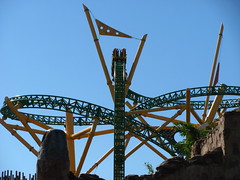 unique setting and terrain features easily had the potential to become the best roller coaster in the southeast. Instead they built an awkward wandering layout for an awkwardly inconsistent family coaster, and even more awkwardly named it “Cheetah Hunt”. And I can no longer convince myself that this is actually a good ride.
unique setting and terrain features easily had the potential to become the best roller coaster in the southeast. Instead they built an awkward wandering layout for an awkwardly inconsistent family coaster, and even more awkwardly named it “Cheetah Hunt”. And I can no longer convince myself that this is actually a good ride.
I want to break this down in more detail, since it seems to be an unpopular position to say I out-and-out don’t like Cheetah Hunt. Even accepting the idea that this was intended to be a mid-level coaster to bridge the divide between white knucklers like Montu and the more timid animal safari attractions, I still must take issue with a host of decisions regarding the design. For one, despite being padded with long stretches of gentle mine train-like weaving, the upfront placement of screaming LSM launches and a vertical tower, not to mention a big corkscrew in view of the midway, are all specific features that keep many novice riders apprehensive. Many kids are less turned off by sheer size or force than they are by feelings of uncertainty or surprise, which are sensations the Blitz coaster hardware is specialized to produce. Secondly, being a family coaster is no excuse for a poorly sequenced, uninvolving layout. It’s not necessarily that Cheetah Hunt lacks any good or memorable moments, but that the good moments tend to be isolated events that randomly occur throughout the course; most notably
weaving, the upfront placement of screaming LSM launches and a vertical tower, not to mention a big corkscrew in view of the midway, are all specific features that keep many novice riders apprehensive. Many kids are less turned off by sheer size or force than they are by feelings of uncertainty or surprise, which are sensations the Blitz coaster hardware is specialized to produce. Secondly, being a family coaster is no excuse for a poorly sequenced, uninvolving layout. It’s not necessarily that Cheetah Hunt lacks any good or memorable moments, but that the good moments tend to be isolated events that randomly occur throughout the course; most notably a solitary barrel roll, which happens without warning and ultimately foreshadows no similar maneuvers in the future that one might expect could be reprised before the very end. Accordingly, rider’s emotional levels are all over the place, jumping back and forth between the exciting, the entertaining, and the underwhelming, often with little rhyme or reason (although a macro-view of the sequence reveals an experience that starts high and ends low, one of the cardinal sins of coaster design). Especially for a long, multi-part layout like this, controlling the emotional narrative is one of the most powerful devices in the in the designer’s toolbox, but instead it’s left to chance wherever the individual bits happen to fit.
a solitary barrel roll, which happens without warning and ultimately foreshadows no similar maneuvers in the future that one might expect could be reprised before the very end. Accordingly, rider’s emotional levels are all over the place, jumping back and forth between the exciting, the entertaining, and the underwhelming, often with little rhyme or reason (although a macro-view of the sequence reveals an experience that starts high and ends low, one of the cardinal sins of coaster design). Especially for a long, multi-part layout like this, controlling the emotional narrative is one of the most powerful devices in the in the designer’s toolbox, but instead it’s left to chance wherever the individual bits happen to fit.
Not helping is the fact that, while it might look great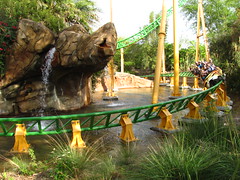 from the midways, most of the decorations in the immediate sightline from onboard are characterized less by the environment of a cheetah stalking its prey than it is by gravel, cement, cinderblocks, corrugated steel trenches, and industrial-looking safety catwalks. There’s a section midway through the layout (after an arbitrary straight-away) when we suddenly find ourselves inches above a rapidly flowing river, agilely skipping back and forth between a narrow canyon, and the moment amazes because it’s the first time the coaster distinguishes itself with a sustained visual and kinetic identity. Following up, the third launch has little visceral impact on the riders, and instead serves a purely functional purpose to help push the cars over the last couple of hills after accidentally running out of momentum at the far end of the course,
from the midways, most of the decorations in the immediate sightline from onboard are characterized less by the environment of a cheetah stalking its prey than it is by gravel, cement, cinderblocks, corrugated steel trenches, and industrial-looking safety catwalks. There’s a section midway through the layout (after an arbitrary straight-away) when we suddenly find ourselves inches above a rapidly flowing river, agilely skipping back and forth between a narrow canyon, and the moment amazes because it’s the first time the coaster distinguishes itself with a sustained visual and kinetic identity. Following up, the third launch has little visceral impact on the riders, and instead serves a purely functional purpose to help push the cars over the last couple of hills after accidentally running out of momentum at the far end of the course,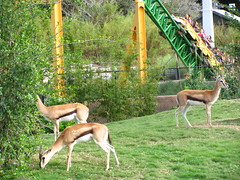 remarkably similar to a couple of my flubbed designs in RollerCoaster Tycoon. (Now that we have the technology for multi-launch coasters, why hasn’t anyone thought to build a layout that steadily increases the intensity from beginning to end, Stairway to Heaven style?) The finale chosen to follow the third launch seems to match the sensation of driving slowly down a winding country road, when it realizes you’re about to miss the address so it veers a hard left while abruptly slamming on the brakes. Thereupon ends the hunt for cheetahs.
remarkably similar to a couple of my flubbed designs in RollerCoaster Tycoon. (Now that we have the technology for multi-launch coasters, why hasn’t anyone thought to build a layout that steadily increases the intensity from beginning to end, Stairway to Heaven style?) The finale chosen to follow the third launch seems to match the sensation of driving slowly down a winding country road, when it realizes you’re about to miss the address so it veers a hard left while abruptly slamming on the brakes. Thereupon ends the hunt for cheetahs.
There are enough moments when the coaster randomly does something interesting that most people can mentally edit out the rest of the fluff and conclude that overall it was a good ride after it’s done. I like that it’s long, smooth, and does lots of different tricks. Maybe Busch Gardens was content to build a coaster that would have visitors equivocate over its merits before eventually deciding that it’s decently fun enough, especially when most customers will respond favorably to the mere presence of any technologically impressive roller coaster they happen to plop down. But it could have used its multi-part structure to tell a great and compelling drama, and instead its design was settled by drawing ideas out of a hat to achieve an indifferent equivalent of Coaster Dada.
of different tricks. Maybe Busch Gardens was content to build a coaster that would have visitors equivocate over its merits before eventually deciding that it’s decently fun enough, especially when most customers will respond favorably to the mere presence of any technologically impressive roller coaster they happen to plop down. But it could have used its multi-part structure to tell a great and compelling drama, and instead its design was settled by drawing ideas out of a hat to achieve an indifferent equivalent of Coaster Dada.
Grade: C+
Sky Ride
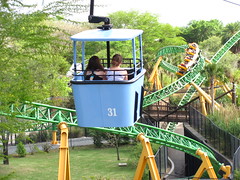 Boarding opposite the loading platform of Cheetah Hunt, the Busch Gardens Sky Ride is a decidedly gentler experience on the body, although one can’t write off the distinct thrill of dangling on a wire in a steel tub over African wildlife as the wind plays games. Along with the Serengeti Express, this is one of two officially designated ways to view the animals roaming the expansive reserve area, although nearby coaster activity and a route that sticks near the midways mean shutterbugs looking for the perfect angle of the antelope are probably better off staying near the ground.
Boarding opposite the loading platform of Cheetah Hunt, the Busch Gardens Sky Ride is a decidedly gentler experience on the body, although one can’t write off the distinct thrill of dangling on a wire in a steel tub over African wildlife as the wind plays games. Along with the Serengeti Express, this is one of two officially designated ways to view the animals roaming the expansive reserve area, although nearby coaster activity and a route that sticks near the midways mean shutterbugs looking for the perfect angle of the antelope are probably better off staying near the ground.
Grade: C
Serengeti Express
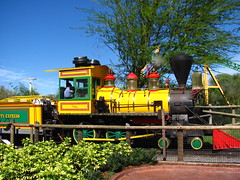 As far as scenic transport rides go, this is less exciting than the Sky Ride and you have to put up with large herds of tourists to watch the small herds of animals. However, it also offers a route along the back of the Serengeti Plain reserve that’s home to a few species that cannot be seen up close from anywhere else in the park that doesn’t require a VIP ticket, and it drops you off in a different location than you started so there’s some practical value in it as well. If you brought a camera and want to watch the animals, take the train. If you want to rest for a bit in between power-riding Cheetah Hunt and Montu, take the Sky Ride. If you’re here for two days or more, then there’s no reason not to try both.
As far as scenic transport rides go, this is less exciting than the Sky Ride and you have to put up with large herds of tourists to watch the small herds of animals. However, it also offers a route along the back of the Serengeti Plain reserve that’s home to a few species that cannot be seen up close from anywhere else in the park that doesn’t require a VIP ticket, and it drops you off in a different location than you started so there’s some practical value in it as well. If you brought a camera and want to watch the animals, take the train. If you want to rest for a bit in between power-riding Cheetah Hunt and Montu, take the Sky Ride. If you’re here for two days or more, then there’s no reason not to try both.
Grade: C
Busch Gardens probably describes this as some sort of fantastical African safari encounter experience, but let’s be honest: Edge of Africa is a zoo. Its remove from the hustle of the main midways and roar of the steel coasters makes it a decidedly tranquil area of the park to retreat to, and the up-close viewing opportunities of an eclectic array of species (including a number of flightless birds that roamed freely among the visitors; are these native to Florida or intentionally placed here by Busch Gardens?) ensures that anyone who originally intended to use it as a shortcut from Egypt to Timbuktu will quickly find themselves a wandering admirer of flora and fauna trapped for the better part of an hour.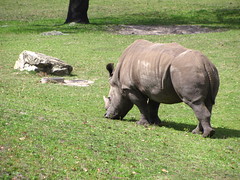 I accidentally stumbled upon a feeding demonstration with the lions, where the animal keepers explained that the balls of ground meat had to be thrown at the lounging felines because they only eat food that they can catch moving, and I couldn’t have been more fascinated.
I accidentally stumbled upon a feeding demonstration with the lions, where the animal keepers explained that the balls of ground meat had to be thrown at the lounging felines because they only eat food that they can catch moving, and I couldn’t have been more fascinated.
Grade: B-
Rhino Rally
This attraction is a problem and something needs to be done to fix it, fast. The river canyon half was repurposed for Cheetah Hunt, leaving the remaining off-road safari section severely broken and in need of a total overhaul. Admittedly I wasn’t a huge fan of the original Rhino Rally. The flash flood section played too much like a simulated theme park gimmick, one that seemed more pleased with its own cleverness than it’s ability sustain a real sense of peril, and now that the river canyon has been repurposed into the best feature of Cheetah Hunt I won’t mourn its loss in the slightest. However, they’ve now resorted to an overblown Jungle Cruise-style comedic narration to make up the difference in entertainment value, with our guide in particular letting no chance for scatological humor go to waste. “Look at that big pile over there, everyone! Isn’t rhinoceros poo funny? I think this makes it time for another dung beetle joke!” This tone is okay if the gators and hippos we’re made to laugh at are obviously artificial (on the Jungle Cruise the attraction’s semi-cheesy outdatedness becomes a ‘secret’ in-joke
of the original Rhino Rally. The flash flood section played too much like a simulated theme park gimmick, one that seemed more pleased with its own cleverness than it’s ability sustain a real sense of peril, and now that the river canyon has been repurposed into the best feature of Cheetah Hunt I won’t mourn its loss in the slightest. However, they’ve now resorted to an overblown Jungle Cruise-style comedic narration to make up the difference in entertainment value, with our guide in particular letting no chance for scatological humor go to waste. “Look at that big pile over there, everyone! Isn’t rhinoceros poo funny? I think this makes it time for another dung beetle joke!” This tone is okay if the gators and hippos we’re made to laugh at are obviously artificial (on the Jungle Cruise the attraction’s semi-cheesy outdatedness becomes a ‘secret’ in-joke between the skipper and the passengers), but when the jokes are at the expense of living creatures held in captivity it just comes across as crass and disrespectful. Additionally, with the river recycled the total safari time takes about five minutes to complete, with roughly as many observable species along the route. So not only is the new Rhino Rally boring and awful, it’s also all over much too quickly. Then again isn’t that true about so much else in life?
between the skipper and the passengers), but when the jokes are at the expense of living creatures held in captivity it just comes across as crass and disrespectful. Additionally, with the river recycled the total safari time takes about five minutes to complete, with roughly as many observable species along the route. So not only is the new Rhino Rally boring and awful, it’s also all over much too quickly. Then again isn’t that true about so much else in life?
Grade: F
Flat rides like this in a big park like Busch Gardens are like stocking stuffers on Christmas morning. Their petite, uncomplicated nature and how they’re discovered as a ‘bonus’ worthy to be presented alongside far bigger goodies makes me want to enjoy them more than I ever actually do. This small suspended scrambler-like ride is the smallest and cutest of the several stuffers populating the Timbuktu section, and does the job of bringing a smile to our face for a minute, even if no one really cares when it’s sent to a recycling plant a week later. (Sandstorm is currently slated for replacement with what’s rumored to be a drop tower attraction.)
Scorpion
I suspect a great many visitors might walk right on by the Scorpion without giving it a ride. Some might immediately dismiss the compact portable steel looping coaster as a diminutive relic from a time when Busch Gardens’ biggest competitor was the Florida State Fair rather than Disney’s Animal Kingdom, and other might turn away after getting a look at the length of the slow-moving queue. But for those that stick out the wait in the tight cattle corral queue (or visit on a quiet day) they can expect a delightfully fun ride at the end of it. Layers of helices that alternate between forceful and leisurely, tied together by the singular vertical loop that is always best experienced with a simple lap bar and nothing more, always make for an enjoyably brief ride. Not quite a classic, but it achieves as much with its succinct layout as certain other single-looping coasters two-and-a-half times its length are able to. Also, credit is due to Busch Gardens’ maintenance department for keeping the Scorpion looking as fresh as the bigger 21st century scream machines built nearby.
forceful and leisurely, tied together by the singular vertical loop that is always best experienced with a simple lap bar and nothing more, always make for an enjoyably brief ride. Not quite a classic, but it achieves as much with its succinct layout as certain other single-looping coasters two-and-a-half times its length are able to. Also, credit is due to Busch Gardens’ maintenance department for keeping the Scorpion looking as fresh as the bigger 21st century scream machines built nearby.
Grade: C+
Phoenix
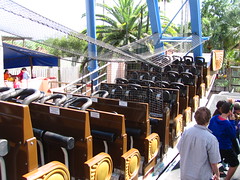 I’m not much of a flat ride fan, but there’s often one or two in a park this size that will catch my eye and make me think “I have got to try that”. Usually they’re the flat rides that aren’t very flat, as is the case of the Phoenix, an Intamin Looping Starship that sends you around a vertical loop nearly 100 feet in diameter. The pace is rather slow and leisurely so you get to enjoy the hangtime as you go around the top. While it’s a kewl retro ride, I wouldn’t mind if they updated the seats and restraints, as “ergonomics” was a term unfamiliar to the Intamin of the 1980’s.
I’m not much of a flat ride fan, but there’s often one or two in a park this size that will catch my eye and make me think “I have got to try that”. Usually they’re the flat rides that aren’t very flat, as is the case of the Phoenix, an Intamin Looping Starship that sends you around a vertical loop nearly 100 feet in diameter. The pace is rather slow and leisurely so you get to enjoy the hangtime as you go around the top. While it’s a kewl retro ride, I wouldn’t mind if they updated the seats and restraints, as “ergonomics” was a term unfamiliar to the Intamin of the 1980’s.
Grade: C
Sand Serpent
 This was actually the first wild mouse coaster I ever rode, back in 1996 when it first opened at sister park Busch Gardens Williamsburg with the temporary Atlanta Summer Olympics mascot tie-in as Wild Izzy. My recollection of it from Williamsburg was that it was the only coaster everyone else in my family would not ride again because the lateral switchback turns were too scary compared to, say, the six loops on Drachen Fire, despite the fact that it’s classified as a supposedly milder “family coaster”. The 4-passenger cars have changed species a few times since then, from mice to cheetahs and now reptiles (plus whatever the hell an “izzy” was supposed to be), and it was kind of fun to finally ride it again after all these years. While it’s certainly nothing to be afraid of, I can easily see how the whiplash turns and drops might be off-putting to many
This was actually the first wild mouse coaster I ever rode, back in 1996 when it first opened at sister park Busch Gardens Williamsburg with the temporary Atlanta Summer Olympics mascot tie-in as Wild Izzy. My recollection of it from Williamsburg was that it was the only coaster everyone else in my family would not ride again because the lateral switchback turns were too scary compared to, say, the six loops on Drachen Fire, despite the fact that it’s classified as a supposedly milder “family coaster”. The 4-passenger cars have changed species a few times since then, from mice to cheetahs and now reptiles (plus whatever the hell an “izzy” was supposed to be), and it was kind of fun to finally ride it again after all these years. While it’s certainly nothing to be afraid of, I can easily see how the whiplash turns and drops might be off-putting to many new riders, which worries me that they’ll permanently avoid far gentler rides like Kumba or SheiKra for those reasons.
new riders, which worries me that they’ll permanently avoid far gentler rides like Kumba or SheiKra for those reasons.
Grade: D+
Air Grover
It makes sense that Busch Gardens would want to make reference to the Sahara in some of their attractions, but honestly deserts are one of the worst themes possible; at least, they are if the theme is dryly interpreted as “circling around on an empty lot of sand”, in which case is it really much better than the kiddy coaster they set up on the old pasture for the local 4-H carnival? In all other respects this Zierer coaster is like the one at SeaWorld Orlando, but with a smaller layout that lacks the somewhat violent dips and turns that characterize similarly sized rides from Miler or Zamperla.
In all other respects this Zierer coaster is like the one at SeaWorld Orlando, but with a smaller layout that lacks the somewhat violent dips and turns that characterize similarly sized rides from Miler or Zamperla.
Grade: D-
SheiKra
Honestly, what most amazed me about SheiKra: a 200 foot tall B&M Dive Machine (painted in bright primary colors) somehow managed to appear perfectly at home amid botanical gardens. Not that I would call these types of coasters eyesores, but the bulking steel track and strong vertical lines created by the support columns do have a tendency to rob the visual attention away from the surrounding environments, and since these machines aren’t built with aesthetic value as the top priority I wouldn’t necessarily call that trait a virtue of their design. Somehow Busch Gardens managed to pull it off, utilizing several tall brick turrets to either hide or balance the visual dominance of the modern steel structure, and uniting it all around a plaza with a water splashdown finale that’s even more fun to watch than to ride. Likewise, riding the coaster is all about the visual experience, whether it be from the top of the lift surveying the surroundings (including Tampa’s skyscrapers in the distance), from the front row watching your feet dangle above 200 feet of open air, or from a coveted edge seat watching the world blur into a colorful impressionistic landscape
columns do have a tendency to rob the visual attention away from the surrounding environments, and since these machines aren’t built with aesthetic value as the top priority I wouldn’t necessarily call that trait a virtue of their design. Somehow Busch Gardens managed to pull it off, utilizing several tall brick turrets to either hide or balance the visual dominance of the modern steel structure, and uniting it all around a plaza with a water splashdown finale that’s even more fun to watch than to ride. Likewise, riding the coaster is all about the visual experience, whether it be from the top of the lift surveying the surroundings (including Tampa’s skyscrapers in the distance), from the front row watching your feet dangle above 200 feet of open air, or from a coveted edge seat watching the world blur into a colorful impressionistic landscape as the Immelmann inversions torques you around several axes at once. Despite the 70mph top speed it’s quite gentle on the human body, although from the last row it easily wins the award for Most Airtime on a Roller Coaster in the State of Florida. (Considering it only has two weightlessness-producing drops, that probably speaks a lot more about other coasters in Florida.) Yet in the end my feelings toward SheiKra are a bit like watching a Romantic period opera: perfect technique that I could admire all day long, yet I can’t help but feel that I wasn’t the intended audience. It’s a style that values a different set of qualities than those that drew me to the artistic medium in the first place.
as the Immelmann inversions torques you around several axes at once. Despite the 70mph top speed it’s quite gentle on the human body, although from the last row it easily wins the award for Most Airtime on a Roller Coaster in the State of Florida. (Considering it only has two weightlessness-producing drops, that probably speaks a lot more about other coasters in Florida.) Yet in the end my feelings toward SheiKra are a bit like watching a Romantic period opera: perfect technique that I could admire all day long, yet I can’t help but feel that I wasn’t the intended audience. It’s a style that values a different set of qualities than those that drew me to the artistic medium in the first place.
Grade: B
Classic 1970’s log flumes by Arrow Dynamics are always a solid entertainment option, and while the same is true here, Stanley Falls unfortunately ranks near the bottom of the bunch. With only two short drops (the largest is 43 feet deep) and a relatively brief three minute layout around a basic plot of subtropical Floridian landscaping, a couple of cool bits like Arrow’s rolling speed flume section after the first drop can’t save it from the feeling that this is an outdated catalog purchase before Busch Gardens knew that they would be competing with big brand theme parks to the east. Perhaps the nearby Tanganyika Tidal Wave makes up for it, but given the chilly temps I wasn’t going to get wet on both.
Jungala
While some coaster lovers might be still sore from the time that a kid’s climbing playground replaced the classic 1976 Arrow corkscrew coaster Python (you can decide if I intended the phrase “still sore” to be a pun or not), the animal exhibit side of Jungala is worth a stroll through if you’re passing by on the way between coasters. The jungle critters are mostly represented by Bengal tigers and orangutans (not in the same enclosure, obviously), and if you’re lucky you might find yourself separated from one of the residents by a fraction of an inch of Plexiglas; a notable example being a small subterranean lookout in the middle of the tiger habitat, which during my visit one of the big kitties evidently found made a good bed.
a small subterranean lookout in the middle of the tiger habitat, which during my visit one of the big kitties evidently found made a good bed.
Grade: C+
Kumba
Beautiful. The iconic 1993 sit-down B&M looper could be perceived as exceedingly vanilla by today’s standards, especially in the context of the thirty-odd multi-looping coasters the Swiss company produced in the time since that all originate somewhere from Kumba’s DNA. Yet even as new technical innovations and twists on the basic layout came along, Kumba somehow manages to remain the best example of the genre for its grace and simplicity. It’s not a layout about big ideas or a dramatic crescendo. Every element is like a line of poetry, with balanced contrasts between the emotional highs and lows, and not a single length of track either wasted or overemphasized; each moment is an integral component to forming an overall aesthetically pleasing tapestry. The first half could be called “The Young Person’s Guide to the Roller Coaster”, the way it introduces the basic vertical loop and then each subsequent inversion expands on the idea with a new orientation or greater level of complexity until peaking in the two-part cobra roll. Thus the task set for the second half is to gradually wind down the action in a way that doesn’t also feel anticlimactic, and Kumba succeeds in a way that its many copycats have rarely been able to.
to remain the best example of the genre for its grace and simplicity. It’s not a layout about big ideas or a dramatic crescendo. Every element is like a line of poetry, with balanced contrasts between the emotional highs and lows, and not a single length of track either wasted or overemphasized; each moment is an integral component to forming an overall aesthetically pleasing tapestry. The first half could be called “The Young Person’s Guide to the Roller Coaster”, the way it introduces the basic vertical loop and then each subsequent inversion expands on the idea with a new orientation or greater level of complexity until peaking in the two-part cobra roll. Thus the task set for the second half is to gradually wind down the action in a way that doesn’t also feel anticlimactic, and Kumba succeeds in a way that its many copycats have rarely been able to. The interlocking corkscrews (returning to the basics while still injecting a new dynamic on the riders) are simultaneously elegantly paced while biting just a little bit with the snappy rotation changes, and then the lull before the tunnel dive and upward helix satisfies as a grand finale while bringing our adrenaline slowly back down to earth so that the brakes triggering doesn’t come as a shock or disappointment. Even the way the grassy terrain contours around the sky blue track helps strengthen the perception that every piece is part of a perfectly realized whole. The simple looping progression isn’t outwardly a daring idea, but if after a few rides you get hit by the simple beauty of Kumba, it will hit you hard. Kumba is the rare coaster that I could ride a hundred times over without the repetition growing tedious. Thankfully, the location at the far back
The interlocking corkscrews (returning to the basics while still injecting a new dynamic on the riders) are simultaneously elegantly paced while biting just a little bit with the snappy rotation changes, and then the lull before the tunnel dive and upward helix satisfies as a grand finale while bringing our adrenaline slowly back down to earth so that the brakes triggering doesn’t come as a shock or disappointment. Even the way the grassy terrain contours around the sky blue track helps strengthen the perception that every piece is part of a perfectly realized whole. The simple looping progression isn’t outwardly a daring idea, but if after a few rides you get hit by the simple beauty of Kumba, it will hit you hard. Kumba is the rare coaster that I could ride a hundred times over without the repetition growing tedious. Thankfully, the location at the far back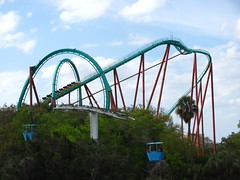 of the park with an easy to overlook entrance means that on a quiet day there will be little standing in the way of that objective.
of the park with an easy to overlook entrance means that on a quiet day there will be little standing in the way of that objective.
Grade: A-
Summary
While it’s probably not of much cultural value relative to the body of artistic works about Africa from other media, as an amusement/ theme park hybrid Busch Gardens Tampa finds the right balance to be in turns relaxing, exhilarating, and sometimes even beautiful.
Overall Grade: B+


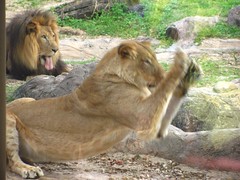

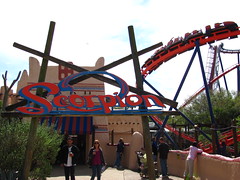

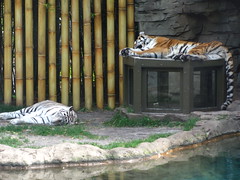
“….as visually effective as observing dolphins from a water slide.”
BOOM. Greatest line in coaster review history. Awesome.
I also admire Kumba. I even called it my favorite B&M before I ever rode it (I was young). The love started way back in the 90’s watching those old VHS tapes you mentioned in a previous review. Finally had the chance last summer and my thoughts were easily confirmed.
Is being the, “first,” of an archetype really that valuable? It seems we always hold value to the “first” as coaster lovers. Each copy gets less and less valuable.
Do the designers simply shoot their wad on their initial designs?
Or is the collective product of Kumba simply better than all others, regardless of its chronological value in B&M designs?
/////break/////
So glad you mentioned the comparison between Montu and Kumba. I never thought to compare the element-differences between the two as a conscious efforts to avoid an in-the-park repeat. For some reason I always thought they were trying to be different than Raptor.
Ken, I also thought about the reason Kumba seems to have value attached for being the archetype, and my conclusion was that the reason Kumba is successful is because every piece fits together and there’s nothing extraneous in the design. Subsequent designs that aren’t exact copies of this layout invariably have to change things to be different, and then you’re basically just adding or subtracting syllables from a haiku. If next year someone were to copy Kumba’s layout and setting, but put Wildfire trains on the track with a fitting on-board soundtrack, then that would definitely be the better coaster in my opinion.
If Kumba were the archetype for a more dramatic coaster that focused more on surprises and dynamic contrasts, then I think it would be very likely that subsequent rides would improve on the original. Perhaps the evolution of Great Coasters Intl. is a good example of this; their newer stuff generally seems to improve on older designs.
Another big part of why I like Kumba so much is how it seems to fit into the terrain. Most of the B&M coasters that followed are built over flat land (or they seem to conflict with the uneven terrain they’re given), so there’s also that reason for why Kumba alone seems to be regarded slightly above similar coasters. So, I’d say it’s more your third proposal.
By the way, there’s definitely a lot of Raptor in Montu as well. Raptor was kind of a Batman-Kumba hybrid to begin with, so it makes sense that you can find examples of them sharing the same genes, even if it means doing the opposite instead of copying directly. I’m fairly certain the batwing came about because they didn’t want two cobra rolls, although perhaps if Kumba never existed they would have included it anyway.
A couple years ago Animal Kingdom started to get new coats of paint on a lot of the park. More than just basic rehab, the intention was to make the park appear “cleaner”. Apparently guests had come to agree with the prevailing Lutzish wisdom that the park was simply too realistic with its attempts at theming. Dino-A-Rama was too lame and cheap looking, the Africa and Asia sections looked too weathered and worn. Essentially, they were too close to being “real” for the guests to be comfortable.
See, when my wife and I go to World Showcase, we look at the pavillions there as what they are – big advertisements by the home country’s tourism board to go see those places. And we have memories of more than half the nations there to dwell on as we walk the grounds and think of things that we’re reminded of by being there. But for a lot of visitors, that’s not the case. There’s a substantial number, the percentage of which I am unsure, for whom the World Showcase is a *replacement* for actual globe hopping. Why see Inca/Mayan ruins when there’s a step pyramid right here in Orlando filled with treasures, tacos, and a fun dark ride starring the Three Caballeros?
Africa is an enormous continent and they had the opportunity to do amazing things with the themes it offers, but Busch really didn’t take advantage of it from the start. I mean, they chose to build the park’s Festhaus in the Timbuktu section. Fun name to use for an area, sure, but choosing an arid islamic nation as the home for your faux-beer tent is fucking funny when you think about it.
IMO its a pretty good sub-elite theme park that has all the pieces youd want from an elite facility, but doesn’t really put them together in a way that makes it a truly awesome park. I think of it in the same terms then as Phantasialand or Heide Park. Also, I’ve actually heard several people say they thought Cheetah Hunt was plenty lame, so that’s just more reinforcement for that position. I’ve never heard anything positive other than comparisons to California Screamin’.
For once I can comment on a review with recent experience as I happen to be in Florida at the moment, (last two days of a two week vacation), and was actually at Busch Gardens today!
I too like Busch gardens and for many of the reasons you give, Jeremy. I find the environment very pleasant and I think you correctly identified the reason as being related to the lack of narrative theming but plenty of visual theming.
However, I don’t agree with your coaster reviews… I suspect that may be an age thing, (I’m 51and frankly don’t have the capacity for re-riding coasters that I used to have), but I also think you are applying a set of review criteria that to some extent misses the point of some coasters…
Montu I agree totally with you. Smooth but forceful and interesting. 4 years ago it was the most popular coaster in the park but today it was a walk on all day. I’ll come back to why later…
Shriekra I also agree. I used to be scared of heights and riding it 4 years ago made me very nervous…. until the first drop was over and I realised it was so smooth and thrilling and I have loved it ever since. Visually it is stunning but it rides even better than it looks.
Kumba however is a different beast entirely. I want to love Kumba so much for all the reasons you state. It has a great sequence of elements, looks ravishing and for years was a coaster I admired in books and videos. The truth is though that the ride today was horribly rough. It was a walk on today and yet after one ride my wife and I looked at each other and said, “that’s enough”. I simply don’t enjoy being shaken and battered any more so sadly my review of Kumba is ‘great concept and design but not aged well’. (And I am actually very grateful that Gwazi was down today as 4 years ago I remember it being the only only coaster I have ever ridden that I just hung on for dear life and prayed for it to be over, so rough was the experience. There’s a rumour today on Screamscape that it might be in line for the topper track treatment, like Rattler. One can only hope).
Where I disagree most strongly however is with your opinion of Cheetah Hunt. For me this is in my top two Florida coasters along with Manta, but for by different reasons. It’s telling to me that today everything in the park was a walk-on all day except for Cheetah Hunt. I also think it’s relevant here to point out that in a two week period when the weather was consistently wonderful the only parks that were busy were Disney’s, and mostly the Magic Kingdom. What’s the common factor? Family. The money is not in thrill rides that appeal only to hard core coaster fans or late teens and upwards but in attractions with broad age appeal. Where II think Cheetah Hunt succeeds is in offering enough originality and thrill to please seasoned coaster riders but not pushing the envelope too far and so allowing a broad range of riders to enjoy it. I know that isn’t really the way you approach your reviews but I think it matters massively because it dictates how designers and imagineers approach any new project.
As far as the sequencing goes however I think you may have missed something. As we were driving home and talking about the day my wife said ‘I think Cheetah Hunt is the only coaster where I really get the narrative’. And she was able to relate the ride exactly the the theme of the Cheetah hunting its prey…. The bursts of acceleration, the jumping up onto a high outcrop to survey the surrounding land, (cheetahs rely on their eyesight rather than scent to hunt), then jumping down and sprinting across the Serengeti, even jumping and twisting, pursuing the prey through a canyon then once again bounding across the plain. You saw it as a random, disjointed sequence, but to my wife it made perfect sense and combined a smooth, fun-filled ride with a few highlight thrills with a story that was under-stated but very present. We both loved it and rode it 4 times in both front and back. (The last time something malfunctioned and the second launch failed. We rolled back and sat for ten minutes until they resolved the issue then we got to launch up the tower from a standing start. Highlight of the day!)
I think Busch Gardens have got it exactly right with Cheetah Hunt, from theming to design. It’s original and it might not tick your hardened coaster-enthusiast happy boxes but I think for the vast majority of us it’s a perfect pitch of thrills and fun. Judging by the reactions of the people I saw coming off it they loved it too. It absolutely makes Busch Gardens for me… An A-, possibly even a perfect A.
Having visited all 9 theme parks in the last 14 days I am now full of opinions about the parks and the rides so once I am back to the UK you might find that I post a few of them……
Hi David (finally back from Orlando myself…), it sounds like we’ve had very different experiences with Kumba. Last March it ran perfectly smoothly and was very easy to re-ride many times. Probably even more so than Montu, since Kumba has much gentler forces than some of the first maneuvers on Montu that really push you down into the seat. It my experience coasters can run differently from day to day or even hour to hour, so I usually try not to judge them on roughness unless it’s something I’ve heard from many other sources across a longer period of time. The most I’ve ever heard anyone else was that Kumba has a bit of an ‘edge’ common to B&M’s earlier work, but you’re the first I’ve heard to call it rough let alone unrideable.
As for Cheetah Hunt, I mentioned in my review that I was willing to approach it as a family coaster. No doubt that families are a major demographic for the park that they’re missing somewhat in their coaster lineup, although I still think they chose the wrong hardware to do the job. Intamin Blitz coasters like Maverick are for me right at the top of the list when it comes to the potential to make the highest class of thrill ride (quick direction changes, fast paced inversions, multiple launches/lulls, an emphasis on variety and terrain integration rather than repetition of the same basic maneuvers over a contained plot of land…) and there haven’t been many of them built so far, so it’s disappointing that when the States finally got their second Blitz coaster, it ended up being used to fill a very different set of specifications that aren’t necessarily taking advantage of the concept’s greatest strengths. It’s a bit like if David Lynch announced that he’s going to make another movie but he’s been signed by Disney to direct their next Marvel franchise film. Sure, Marvel is an important brand and if one were directed by Lynch I’d probably see it and it would probably be pretty good for this genre; but it’s not what Lynch is unique for and the time and money would be a missed opportunity to really take advantage of the talent available.
I also understand your points about the theme, but for me it was a concept rich in possibility that they only partly took advantage of. The canyon section is a good example because it’s one of the areas that Cheetah Hunt gets a lot of attention and praise. It’s set in the best area to do a lot of interesting stuff with the terrain in the old Rhino Rally basin, but it wastes a lot of track just to set this one maneuver up. The first time it crosses over this land it’s on a block brake set high above the treeline, the second time it crosses back it runs above the water on a long straight section of track (halfway interesting for the location but they didn’t even try to make it a roller coaster here), finally on the third time it gets to the dynamic switchbacks in the canyon that everyone loves, but then returning on the forth crossover it halts the pacing for another block and launch section where you’re surrounded by a lot of steel and cinderblock. I think if they had planned it out better they could have used the terrain in this area a lot more effectively than on just one out of four crossovers. Same thing with the sprints across the Serengeti, it’s a good idea for a storyboard concept, but the track is too meandering, starting and stopping the idea whenever it’s convenient (the barrel roll is just there because it’s a roller coaster and they could put one there), and the way it’s laid out makes the coaster feel much slower than it actually is.
I would have eliminated the single inversion because it doesn’t serve as a climatic centerpiece moment the way it might on California Screamin’ or SFMM’s Revolution, tucked the profile closer to the ground so the layout’s “theme” is more strongly united by a sense of speed and agile direction changes (except perhaps for the tower, the downbeat moments don’t really play into the cheetah narrative for me, they just feel like bits where the coaster has momentarily lost its pace due to poor layout planning), and made sure I had a clear idea of what the climax and resolution of this narrative is and how to achieve it through a roller coaster. The third launch and return run really does nothing for me because it’s the exact same dynamics as the first run across the plains, only slower and without an inversion to cap it off. Get rid of the first small launch and have the track spiral down to the second launch instead, and trim the tower down so the first launch speed is only around 50/55mph instead of 60mph. First sprint across the plains, keeping the profile lower and get a bit more unpredictability from the direction changes. As it approaches the river canyon there’s a small, ground-level block brake (no inversion) and a small boost (relocated first launch) and it sends the next section on a wild ride through the canyon and circling around the trees and above the water all at ground level. It turns around and has the third block/launch a bit further back (towards Kumba), where it reaches the maximum speed around 68mph, reprises the the first Serengeti plain hunt section only faster, longer, and more dynamic, and finish by scrubbing a bit of speed off with trims and end with a delicate, fun airtime hop into the main brakes. Most of the same elements (sans inversion in exchange for a real cheetah’s top speed) but in a narrative that makes more sense. It doesn’t waste as much track, has fewer ‘scary’ elements upfront (both in on-ride narrative and off-ride presentation), but also has a much more exciting narrative sequence that’s always moving forward instead of randomly pausing, throwing in an idea because it fits, or doubling back on concepts they’ve already tried but with lesser impact.
Hmm, that was probably longer than my actual review. Anyway, please continue to share your opinions on other Florida attractions, it’s always a good thing to get a different viewpoint.
Welcome back Jeremy! And I’ll keep my fingers crossed for good news on the Disney front as regards your future. I’m genuinely excited at the possibility of your design understanding being put to work in the Disney universe. Your focus on narrative integrity could really push the next generation of Disney attractions into greatness…
However, flattery aside….
Thanks for the detailed response to my comments. The Kumba issue may have been partly simply an age thing, (my age not the coaster’s). At 51 I am not as resilient as I used to be and I don’t have the capacity for re-riding that I once had. (And yet I rode Manta 4 times, thrice in succession, so I guess it does depend on the coaster…). Interestingly the only other coaster that I didn’t want to re-ride was Hulk at Islands of Adventure and that was simply because it was late in the day ad it was a VERY forceful ride. But I wonder if there is actually a material difference in the sitting position going on here. Both Kumba and Hulk ate sit-down, traditional enclosed coasters. All the vibration goes straight up into the seat and you get every little bump. At the other extreme Manta, whilst very forceful, has you in the ‘hanging’ position which I think dissipates some of the vibrations. Has anyone else noticed this phenomenon or am I imagining it? I think Kumba was just too rough for us on the day but I would not want to suggest that there was a problem with the coaster itself. I am actually disappointed because as I said in my earlier post I really do like Kumba’s design.
As far as Cheetah Hunt goes I can’t argue with your analysis, but then I don’t think I was saying that it couldn’t have been better… I live in north Wales, a stunningly beautiful area, and I run a guest house so people come to stay here to explore the landscape. I hate it when teh weather is poor and they don’t see it at it’s best, and yet often first time visitors come back after a so-so or bad day or weather raving about how beautiful it all is. I want to say ‘but you don’t know what it COULD be like’, and yet I have come to realise that if they don’t know any better, so to speak, they can still really enjoy what is on offer…
I think Cheetah Hunt works like that for most people. Some coasters people go on for the first time and come off thinking ‘meh’ (to coin a phrase). But regardless of whether CH could have been better, (and your design sounds fantastic), the majority of people love it, possibly because they don’t realise just how good it could have been, but if they still love it does that matter so much?… The danger in that of course is that designers approach projects from the point of view of ‘what can we get away with?’ rather than ‘what will be truly excellent’, but I do think we need to temper our opinions sometimes and strive to understand why something works that we don’t think should necessarily do so…
Does that make sense?
I am still kind of distilling my thoughts on the Florida experience. We’ve been three times now and each time we have made it a different experience. Maybe I’ll think about some of them and post in the Dialogues and see if I can start a discussion…
Thank you for the flattery, David. I’m still waiting for the next response but I think I should have an idea sometime soon.
I think Kumba sounds like a case of riding it on the wrong day. I’m actually surprised you had an easier time on Manta, since I’ve always found the lay down position a bit awkward and encumbering, and the pretzel loop seems like it could be the most forceful single maneuver in the state of Florida (although I think Montu wins it for sustained force and intensity). I hadn’t thought about how the hanging position could help dissipate vibrations, although I’m reminded of a ride on Nighthawk at Carowinds which I would definitely call one of the roughest rides I’ve ever been on and the flying position didn’t seem to help much. I suppose it could also be a case that Manta is simply a much newer coaster and runs much more smoothly than the other Beemers built in the 90’s.
While I agree that a lot of people do evidently like Cheetah Hunt, I’ve also heard them equivocate a lot about its merits before reaching that positive opinion, both from inside and outside coaster enthusiast circles. In fact you’re the first person I’ve heard give it such high marks without qualification, at least among people who put more than a passing thought into their coaster preferences. It’s popularity (gauged from the long lines) doesn’t surprise me: it’s the park’s brand new major attraction, subject to much advertising hype, in a highly visible location near the front gates, and it has lower hourly capacity than any of the other major coasters in the park. The wild mouse also had an advertised 40 minute wait when we were there, so there’s obviously other factors at play besides just high feedback ratings to explain a ride’s long queue.
Perhaps it is a better ride than I gave it credit for, but I had very high expectations for it from the initial rumors and following it through to completion I felt it lived up to very few of them. My feelings during the ride were really only positive during the canyon switchback section. Everywhere else I was nagged by the feeling (present during the ride, before I went through to critically assess it) that it was under-delivering the sensations and emotions that I would have expected from a coaster of this scale and quality design. If I knew every element was bringing us closer to a strong finish then I could have forgiven some of the parts where it seems to wander, but the third launch and return section of track just felt so lackluster especially compared to the earlier track that I could only think about it in terms of “what are the individual components that I like, and how much can I enjoy them within a moment before the layout is back to wandering around and doing things that I’m less excited by?”
God, why do you always complain about everything? You never have anything good to say. Nobody wants to hear a whiny emo bash theme parks. Get a life.
Seriously, if you wanted to tell me that I’m a whiny emo bitch, there were much better reviews on this website for you to call me out on than one that I gave a B+ average grade to. Have you even read the Holiday World reviews? Talk about indulgent, self-satisfied nit-picking. What about Geauga Lake, that one is pretty damn emo too. Try harder next time you want to insult me.